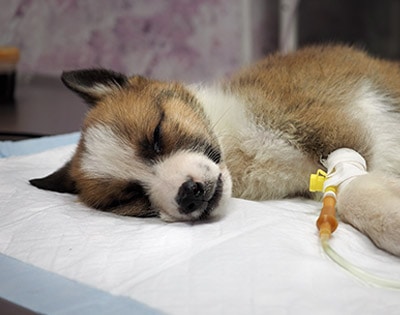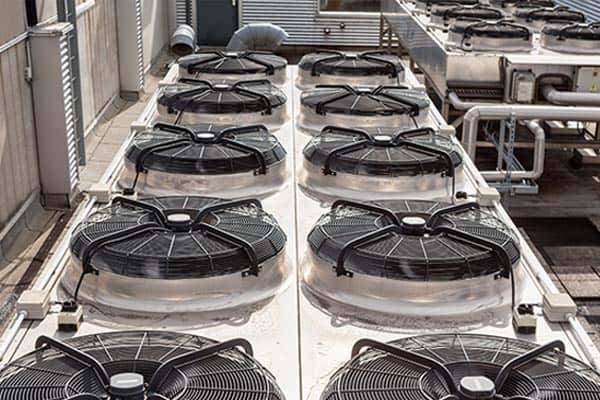
What is Canine Parvovirus?
Also known as: Parvo
Canine parvovirus, known more simply as parvo, is a highly contagious infection caused by a very resistant virus. While all dogs can fall victim to canine parvovirus, this infection most often infects puppies 6–20 weeks old and unvaccinated dogs. It can manifest in two different forms. The most common form attacks the gastrointestinal tract resulting in an inability for the dog to absorb nutrients. The less common form attacks the heart muscles, both of which can be life-threatening.
Aerapy Animal Health’s UV technology was tested against canine parvovirus and achieved a >99.98% kill rate.
Visit our Research & Studies page to learn more.
What causes canine parvo?
Canine parvo is caused by a virus that is very resistant and can linger on surfaces for months. It can live in the soil for as much as one year as it is highly resistant, even to weather changes. Because of this, dogs do not have to come in contact with an actual sick dog; they can contract the virus indirectly by coming in contact with the environment where a sick pet may have been.
How is parvo transmitted?
The virus is shed from an infected dog via stool. A healthy dog can contract the virus as easily as coming in contact with the feces left by an infected dog. Feces may be carried on a dog’s hair or paws and can easily be transferred to a new environment on a human’s body, clothing, or shoes where it can infect other dogs.
What are the symptoms of parvo?
Canine parvovirus is a serious illness with devastating symptoms. The condition can result in death in 48–72 hours when left untreated. It is recommended that the dog receive immediate veterinary care if symptoms of parvo are identified.
How can canine parvovirus be prevented?
As a highly contagious, resistant, and deadly virus, parvo prevention requires a multipronged approach.
Boarding Facilities, Veterinary Clinics, and Animal Shelters
Vaccination procedures are important for every pet care facility. Requiring proof of vaccination against parvo, as well as other diseases, before any dog is brought your facility is the first line of defense for your business.
Proper sanitation is critical for the prevention of many illnesses including parvovirus. Ensure staff members are trained on how to properly clean the facility.
Staff training to recognize and react is imperative. Ensuring staff members are properly trained to recognize illness and that they have protocols for immediate isolation and veterinary care for sick pets will help limit exposure.
For many activities, such as day camp or boarding, it may be best to limit the age to dogs that are over the age needed to complete their vaccine series. That being said, young dogs may still be in contact with other pets through training and socialization classes which are important in young pets. If your facility offers these services, ensure that staff is trained on how to recognize illness, that the pets are current on vaccinations for their age, and that the environment is completely disinfected prior to these pets visiting.
Pet Owners
Vaccination is the most dependable method of preventing parvo. Young puppies are the most susceptible as they can contract parvo before they are old enough to receive all their vaccines. Until a puppy is vaccinated, caution should be used to keep puppies away from areas where large numbers of unknown dogs congregate, such as dog parks. It is also important that owners keep their puppy’s vaccinations on schedule. Puppy vaccinations are typically administered every two to four weeks. Delay in getting the next vaccine can put your puppy at significant risk.
It’s important to note that vaccines are not just for puppies, even adult dogs should be vaccinated. Your veterinarian will recommend the appropriate schedule for your dog based on their age and risk assessment. Regardless, it is important to keep up on your pet’s vaccinations.
Choose pet care wisely. When choosing a pet care facility for your pet for activities such as grooming, doggie daycare, or boarding, ensure that they have a vaccination protocol and policies to limit exposure to any potentially ill pets.
For more information and details for both pet care facilities and pet parents on how best to prevent the spread of infectious disease, visit our kennel cough page.
How is canine parvovirus treated?
The following is not intended as a substitute for professional medical advice, diagnosis, or treatment for your pet. Consult your veterinarian for questions and information regarding your pet’s health.
Because parvo is a virus, there is no specific drug that is used to treat the infection. Parvo is most commonly treated through supportive care including the use of intravenous (IV) fluids to keep the dogs hydrated and nourished. Other medications such as anti-nausea, anti-diarrheal, and antiemetics to stop vomiting will be used to treat the symptoms. Antibiotics may be used to control any secondary infections that may occur.
Initial treatment is recommended to occur in a veterinary hospital where the dog can be kept isolated and closely monitored. In some cases, veterinarians will be able to treat dogs in the home environment but the prognosis for recovery on these cases is lower than with hospitalized care. Either way, isolation of an ill dog is key in protecting the health of other dogs, whether in the same neighborhood, daycare facility, or pet store.
Keeping the dog away from other dogs is not only important for the health of other dogs, but for his health as well. His immune system is severely compromised while he is recovering from parvovirus.
Once a pet has been stabilized through hospitalized treatment, the vet may recommend continued care at home. Once home, it is important to follow all recommendations from your veterinarian and contact them immediately should the pet not continue improving. Once home, ensuring your pet has plenty of fluids and gets plenty of rest will help him continue to recover.
If proper treatment is sought from a veterinarian immediately to control the severe vomiting, diarrhea and subsequent dehydration, dogs can usually recover in about a week’s time. Unfortunately, despite treatment, some dogs will not recover from parvovirus.
For dogs that do respond to therapy, they will have a weakened immune system for months after recovery, making them susceptible to other illnesses. They will also remain contagious for up to 8 weeks after initial symptoms have shown. During this time, it is important to keep them isolated from other dogs especially puppies or other unvaccinated dogs and proper sanitation is vital. Canine parvovirus is not only very contagious, it is exceptionally resistant and can live on surfaces for months.




